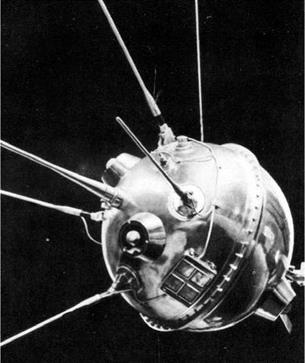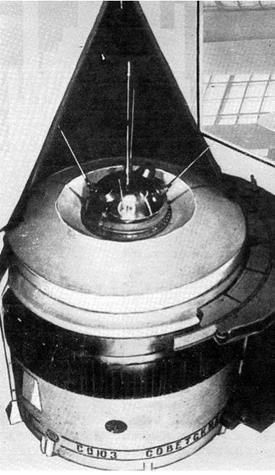FIRST COSMIC SHIP
Undeterred though undoubtedly disappointed, Korolev hoped to be fourth time lucky. He aimed to make his fourth attempt for New Year’s Day. Preparing the rocket in such record times was extremely difficult and the engineers complained of exhaustion. Baikonour was now in the depths of winter and temperatures had fallen to —30°C. There were two days of delays and the probe was not launched until the evening of 2nd January 1959.
Blocks B, V, G and D fell away at the appropriate moment. The core stage, the block A, cruised on. The time came for block A to fall away. Now, Semyon Kosberg’s 1,472 kg small upper stage faced its crucial test. With apparently effortless ease, the stage achieved escape velocity (40,234 km/hour) and headed straight moonwards. The final payload, including the canister, sent moonbound weighed 361 kg, but the actual moon probe was 156 kg. The spacecraft was spherical and although the same shape as the first Sputnik was four times heavier, with a diameter of 80 cm, compared with the 56 cm of Sputnik. It was pressurized and the four antennae and scientific instruments popped out of the top. Signals would be sent back to Earth on 183.6 MHz for trajectory data and 19.993 MHz for scientific instruments (this is called ‘downlink’) and commands sent up on 115 Hz (‘uplink’). The radio system had been designed and built by Mikhail Ryanzansky of the NII-885 bureau, one of the original Council of Designers. To save battery, signals would be sent back for several minutes or longer at a time at pre-timed intervals, but not continuously. The upper stage also had a transmitter which sent back signals in short bursts every 10 sec for several hours as it headed into deep space.
The spacecraft carried instruments for measuring radiation, magnetic fields and meteorites. The magnetometer was only the second carried by a Soviet spaceship and
|
First Cosmic Ship launch |
|
First Cosmic Ship |
arose from a 1956 meeting between chief designer Sergei Korolev and the first head of the space Magnetic Research Laboratory, Shmaia Dolginov (1917-2001) [3]. He headed the laboratory in the Institute of Terrestrial Magnetism (IZMIRAN) where he had mapped the Earth’s magnetic field by sailing around the world in wooden ships using no metallic, magnetic parts. He worked with Korolev to install a magnetometer on Sputnik 3, which duly mapped parts of the Earth’s magnetic field. Now they would be installed on lunar probes to detect magnetic fields around the moon. The magnetometer was called a triaxial fluxgate magnetometer with three sub-instruments and sensors with a range of —3,000 to 3,000 gammas.
Similarly, ion traps first flown on Sputnik 3 would be used on the lunar probe. Ion traps were used to detect and measure solar wind and solar plasma and were developed by Konstantin Gringauz (1918-1993), who had been flying his traps on sounding rockets as far back as the 1940s. He had famously built the transmitter on Sputnik and was the last man to hold it before it was put in its carrier rocket. The meteoroid detector was developed by Tatiana Nazarova of the Vernadsky Institute. Essentially, it comprised a metal plate on springs which recorded any impact, however tiny. The cosmic ray detector was developed by Sergei Vernov (1910-1982) of the Institute of Nuclear Physics in Moscow, who had been flying cosmic ray detectors on balloons since the 1930s.
Instruments on the First, Second Cosmic Ship
Gas component detector.
Magnetometer (fields of Earth and moon). Meteoroid detector.
Cosmic ray detector.
Ion trap.
1 kg of sodium vapour.
As the probe moved rapidly between 20,000 km and 30,000 km out from Earth, it was possible to use the radio signals to make very precise measurements of its direction and velocity. From these, it was apparent that the spacecraft would not hit the moon after all, though unlike the American spacecraft it would not fall back to Earth. On 3rd January, when 113,000 km out from Earth, the spacecraft released a golden-orange cloud of sodium gas so that astronomers could track it. The cloud was visible in the sky over the Indian Ocean and it confirmed that the probe would come quite close to the moon.
One problem was: what to call it? In Moscow, it was referred to as ‘The First Cosmic Ship’ because it was the first spacecraft to leave the Earth’s gravitational sphere of influence at escape velocity. The Russians appeared reluctant to name it a moon probe, because that would imply that it was supposed to impact on the moon, which of course it was. Already, the Suslov decision was having its baleful impact. On 6th January, Anatoli Blagonravov of the Academy of Sciences denied flatly that it was ever intended to hit the moon but to pass close by instead [4]. Later, in 1963, it was retrospectively given the name of Luna 1. In the West, the first three probes were called Lunik, but this was a media-contrived abbreviation of ‘Luna’ and ‘Sputnik’ and was never used by the Russians themselves. Several of the early designators for the Soviet space programme were unclear and applied inconsistently, but thankfully never as confusingly so as the early Chinese space programme.
On 4th January, the First Cosmic Ship passed by the moon at a distance of 5,965 km some 34 hours after leaving the ground. It went on into orbit around the Sun between the Earth and Mars between 146.4 million kilometres and 197.2 million kilometres. The probe was a dramatic start to moon exploration: it ventured into areas of space never visited before. Signals were picked up for 62 hours, after which the battery presumably gave out, at which point the probe was 600,000 km away.
The first round of results was published by scientists Sergei Vernov and Alexander Chudakov in Pravda on 6th March 1959. More details were given by the president of the Academy of Sciences, Alexander Nesmyanov, opening the Academy’s annual general meeting that spring, which ran from 26th to 28th March. First, no magnetic field was detected near the moon, but scientists were aware that it was possibly too far out to detect one. The magnetometer noted fluctuations in the Earth’s magnetic field as the First Cosmic Ship accelerated away. A contour map of the Earth’s radiation belts was published, showing them peak at 24,000 km and then fall away to a low level some 50,000 km out. Second, the meteoroid detector, which was calibrated to detect dust of a billionth of a gramme, suggested that the chances of being hit by dust on the way out to the moon or back was minimal. Third, in a big finding, Konstantin
|
First Cosmic Ship, top stage |
Gringauz’s ion traps detected how the Sun emitted strong flows of ionized plasma. This flow of particles was weak, about 2 particles/cm2/sec, because the sun was at the low point in its cycle, but the ship’s ion traps had determined the existence of a ‘solar wind’. This was one of the discoveries of the space age and Gringauz estimated that the wind blew at 400 km/sec [5].













